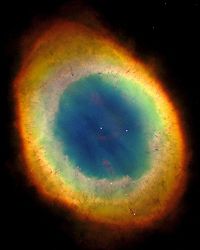Emission nebula

Okay kiddo, let's talk about emission nebulae! They are big, colorful clouds of gas and dust in space that produce their own light.
Imagine going outside on a really dark night and seeing lots of little lights twinkling in the sky. Those are stars, and they shine because they're really hot and bright. When stars are born in a nebula, they heat up the gas and make it glow different colors.
Emission nebulae usually appear red, pink, blue, or green. The colors come from different gases that make up the nebula. For example, hydrogen gas makes the nebula red, while oxygen gas makes it green or blue.
The nebula is like a huge painting in the sky, with different shapes and patterns. Some look like bubbles, others like filaments or loops. Scientists use telescopes to study them and learn more about how stars are born and evolve.
In space, emission nebulae have a really cool effect on the objects around them. They can cause stars to twinkle, and they can even make a galaxy look like a big, glowing patch in the sky.
So, that's the basics of what an emission nebula is. It's like a big, colorful cloud in space that makes its own light, and it helps us learn more about the universe.
Imagine going outside on a really dark night and seeing lots of little lights twinkling in the sky. Those are stars, and they shine because they're really hot and bright. When stars are born in a nebula, they heat up the gas and make it glow different colors.
Emission nebulae usually appear red, pink, blue, or green. The colors come from different gases that make up the nebula. For example, hydrogen gas makes the nebula red, while oxygen gas makes it green or blue.
The nebula is like a huge painting in the sky, with different shapes and patterns. Some look like bubbles, others like filaments or loops. Scientists use telescopes to study them and learn more about how stars are born and evolve.
In space, emission nebulae have a really cool effect on the objects around them. They can cause stars to twinkle, and they can even make a galaxy look like a big, glowing patch in the sky.
So, that's the basics of what an emission nebula is. It's like a big, colorful cloud in space that makes its own light, and it helps us learn more about the universe.
Related topics others have asked about:
